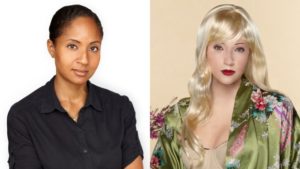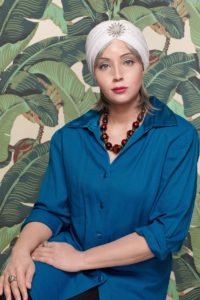
They may question the purpose of the photos and wonder what exactly is supposed to be so provoking about the seemingly simple photos of a woman getting dressed or posing in a yellow sweater.
That is until they realize the white woman they are looking at is a Black woman trying to make a point about her heritage.
Canadian artist Stacey Tyrell is well aware of her parents’ heritage. She is the child of a couple from the West Indian island of Nevis.
To no surprise, if one were to trace her heritage back far enough they would eventually find European ancestors on this Black woman’s family tree.
Considering the history of not only the slave trade but also the origins of ancient civilizations, that finding isn’t surprising to most people
While it isn’t a shocking discovery, Tyrell says it’s still a truth about her past that too often gets overlooked.
“Over the years I have found that a lot of people (often white) get very uncomfortable at the mention of such a connection because they half expect me to launch into a diatribe about colonialism and slavery when all I really seek is an inclusive conversation about the fact that all of us are more related than we think,” she told the Huffington Post.
Of course, some scientists would argue that we are even more related than Tyrell’s own photo set seems to suggest as more and more studies suggest that all of modern civilization actually originated from Africa.
But that isn’t exactly the message Tyrell cared to flaunt with this photography project.
Instead, she just hoped to draw on the fact that perhaps the lines between Black and white are far more blurred than people typically perceive them to be.
That’s when she came up with the idea for her controversial, provocative “Backra Bluid” project—the title is a combination of the Caribbean slang term for “white master” or “white person” and the Scottish term for “kin.”
With the help of a collection of wigs, an extensive wardrobe and some body paint, Tyrell set out to transform herself into the image of some of her European ancestors.

She also explained that she believed much of the pushback she receives after mentioning her European heritage is a direct result of how uncomfortable it is for many white people to be reminded of the “brutal system of colonial African slavery and its legacy that has brought such connections.”
In other words, the message that she has ancestors from Europe serves as an unintended reminder of the cruelties that her own ancestors faced at the hands of slave owners and other fairer-skinned people who mistreated Black people.
She may have never had those European ties, she explains, if it weren’t for the cruelties of those who decided they had the right to rape and sexually abuse her Black ancestors.
While she insists that the purpose of the creative project was to focus on the similarities between all people and present a message of unity, the works have received mixed responses.
Some are uncomfortable with what they have deemed “white face.” Others believe the project simply doesn’t have enough context about the origins of her European lineage. Others, however, are simply happy to see a message embracing similarities rather than honing in on differences.
Another group of comments on the images that are circulating the web expressed hope that the project will help people understand that race in its entirety is a socially constructed concept.


